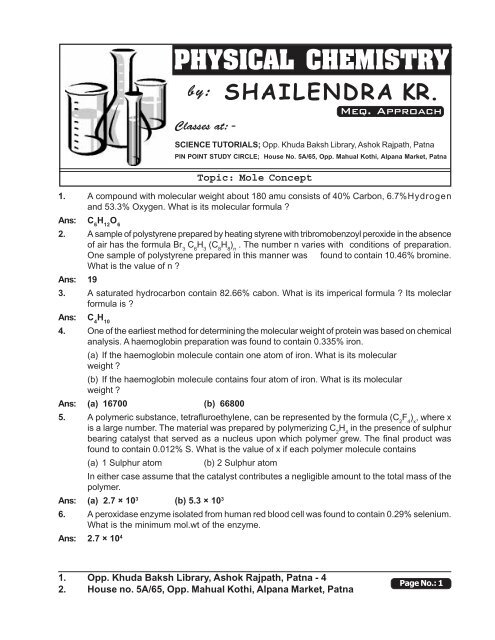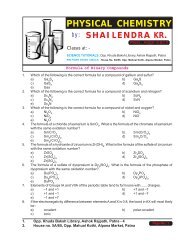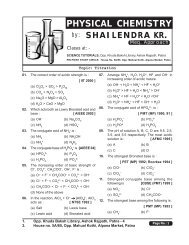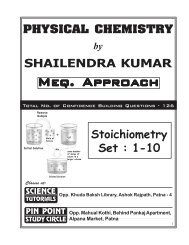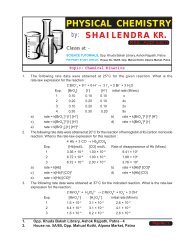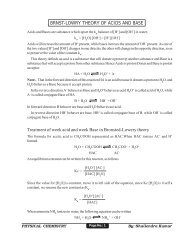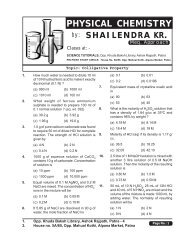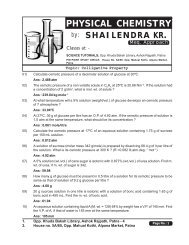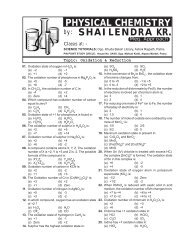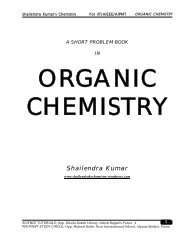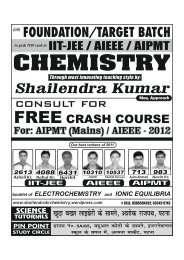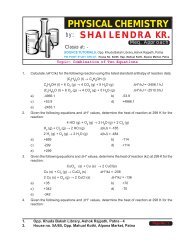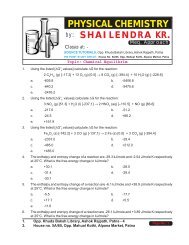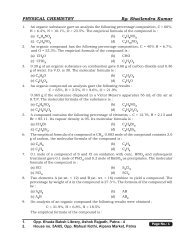Mole Concept (Assignment) - Shailendra Kumar Chemistry
Mole Concept (Assignment) - Shailendra Kumar Chemistry
Mole Concept (Assignment) - Shailendra Kumar Chemistry
You also want an ePaper? Increase the reach of your titles
YUMPU automatically turns print PDFs into web optimized ePapers that Google loves.
PHYSICAL CHEMISTRY By: <strong>Shailendra</strong> <strong>Kumar</strong><br />
PHYSICAL CHEMISTRY<br />
by: SHAILENDRA KR.<br />
Classes at: -<br />
SCIENCE TUTORIALS; Opp. Khuda Baksh Library, Ashok Rajpath, Patna<br />
PIN POINT STUDY CIRCLE; House No. 5A/65, Opp. Mahual Kothi, Alpana Market, Patna<br />
Topic: <strong>Mole</strong> <strong>Concept</strong><br />
1. A compound with molecular weight about 180 amu consists of 40% Carbon, 6.7%Hydrogen<br />
and 53.3% Oxygen. What is its molecular formula ?<br />
Ans: C H O 6 12 6<br />
2. A sample of polystyrene prepared by heating styrene with tribromobenzoyl peroxide in the absence<br />
of air has the formula Br C H (C H ) . The number n varies with conditions of preparation.<br />
3 6 3 8 8 n<br />
One sample of polystyrene prepared in this manner was found to contain 10.46% bromine.<br />
What is the value of n ?<br />
Ans: 19<br />
3. A saturated hydrocarbon contain 82.66% cabon. What is its imperical formula ? Its moleclar<br />
formula is ?<br />
Ans: C H 4 10<br />
4. One of the earliest method for determining the molecular weight of protein was based on chemical<br />
analysis. A haemoglobin preparation was found to contain 0.335% iron.<br />
(a) If the haemoglobin molecule contain one atom of iron. What is its molecular<br />
weight ?<br />
(b) If the haemoglobin molecule contains four atom of iron. What is its molecular<br />
weight ?<br />
Ans: (a) 16700 (b) 66800<br />
5. A polymeric substance, tetrafluroethylene, can be represented by the formula (C F ) , where x<br />
2 4 x<br />
is a large number. The material was prepared by polymerizing C H in the presence of sulphur<br />
2 4<br />
bearing catalyst that served as a nucleus upon which polymer grew. The final product was<br />
found to contain 0.012% S. What is the value of x if each polymer molecule contains<br />
(a) 1 Sulphur atom (b) 2 Sulphur atom<br />
In either case assume that the catalyst contributes a negligible amount to the total mass of the<br />
polymer.<br />
Ans: (a) 2.7 × 103 (b) 5.3 × 103 6. A peroxidase enzyme isolated from human red blood cell was found to contain 0.29% selenium.<br />
What is the minimum mol.wt of the enzyme.<br />
Ans: 2.7 × 104 1. Opp. Khuda Baksh Library, Ashok Rajpath, Patna - 4<br />
2. House no. 5A/65, Opp. Mahual Kothi, Alpana Market, Patna<br />
Meq. Approach<br />
Page No.: 1
PHYSICAL CHEMISTRY By: <strong>Shailendra</strong> <strong>Kumar</strong><br />
7) A purified pepsin isolated from a bovine preparation was subiected to an amino acid analysis.<br />
The amino acid present in smallest amount was lysine, C H N O and the amount of lysine<br />
6 14 2 2<br />
was found to be 0.43 gm per 100 gm protein. What is the minimum mol.wt of protein.<br />
Ans: 34000<br />
8) What volume of 1.71 M NaCl solution contains 0.20 mol NaCl ?<br />
Ans : 117 ml<br />
9) What volume of 3.0 M NaCl (formula weight = 40 gm/mol) can be prepared with<br />
84 gm NaOH.<br />
Ans : 0.70 L<br />
10) What is the molarity of NaOH in a solution which contains 24.0 gram NaOH<br />
dissolved in 300 ml of solution ?<br />
Ans : 2.00 M<br />
11) Calculate the volume of 2.5 M sugar solution which contains 0.400 mol sugar.<br />
Ans : 0.160 L<br />
12) How many ml of water must be added to 200 ml of 0.65 M HCl to dilute the solution to 0.20 M.<br />
Ans : 450 ml<br />
13) How much 1.0 M HCl should be mixed with what volume of 0.250 M HCl in order to<br />
prepare 1.0 L of 0.500 M HCl.<br />
Ans : 667 ml of 0.25 M HCl and 333 ml of 1.0 M HCl<br />
14) What volume of 0.30 M Na SO solution is required to prepare 2.0 L of a solution 0.40M in Na 2 4 +<br />
Ans : 1.3 L<br />
15) Which two of the following solutions contains approximately equal hydrogen ion<br />
concentration ?<br />
(a) 50 ml of 0.10 M HCl + 25 ml H O (b) 50 ml of 0.10 M H SO + 25 ml H O<br />
2 2 4 2<br />
(c) 50 ml of 0.10 M HCl + 50 ml H O (d) 50 ml of 0.10 M H SO + 25 ml H O<br />
2 2 4 2<br />
Ans : a and d<br />
16) If 40.00 ml of 1.6 M HCl and 60.00 ml of 2.0 M NaOH are mixed, what are the molar<br />
concentrations of Na + , Cl – and OH – in the resulting solution ? Assume total volume of<br />
100.00 ml.<br />
Ans : [Na + ] = 1.2 M, [Cl – ] = 0.640 M, [OH – ] = 0.560 M<br />
17) What concentration of NaCl finally results from the mixing of 2.0 L of 4.0 M NaCl<br />
with 3.0 L of 1.5 M NaCl plus sufficient water to dilute the solution to 10.0 L .<br />
Ans : 1.25 M<br />
18) Calculate the concentration of all ion in solution when 3.0 L of 4.0 M NaCl and<br />
4.0 L of 2.0 M CoCl are combined and diluted to 10.0 L.<br />
2<br />
Ans : [Na + ] = 1.2 M, [Cl – ] = 2.8 M, [Co +2 ] = 0.80 M<br />
19) Determine the molar concentration of each ionic species in solution after each of the following<br />
operation:<br />
(a) 200 ml of 2.0 M NaCl is diluted to 500 ml.<br />
(b) 200 ml of 2.0 M BaCl is diluted to 500 ml.<br />
2<br />
1. Opp. Khuda Baksh Library, Ashok Rajpath, Patna - 4<br />
2. House no. 5A/65, Opp. Mahual Kothi, Alpana Market, Patna<br />
Page No.: 2
PHYSICAL CHEMISTRY By: <strong>Shailendra</strong> <strong>Kumar</strong><br />
(c) 200 ml of 3.0 M NaCl is added to 300 ml of 4.0 M NaCl.<br />
(d) 200 ml of 2.0 M BaCl is added to 400 ml of 3.0 M BaCl and 400 ml of water.<br />
2 2<br />
(e) 300 ml of 3.0 M NaCl is added to 200 ml of 4.0 M BaCl . 2<br />
(f) 400 ml of 2.0 M HCl is added to 150 ml of 4.0 M NaOH.<br />
(g) 100 ml of 2.0 M HCl and 200 ml of 1.5 NaOH are added to 150 ml of 4.0 NaCl and<br />
50 ml of water.<br />
Ans : (a) [Cl – ]= 0.800 M, [Na + ] = 0.800 M.<br />
(b) [Ba +2 ] = 0.800 M, [Cl – ] = 1.6 M.<br />
(c) [Na + ] = 3.6 M, [Cl – ]= 3.6 M.<br />
(d) [Ba +2 ] = 1.6 M, [Cl – ] = 3.2 M.<br />
(e) [Na + ] = 1.8 M, [Cl – ] = 5.0 M, [Ba +2 ] = 1.6 M.<br />
(f) [Cl – ]= 1.45 M, [Na + ]= 1.09 M, [H + ]= 0.364 M.<br />
(g) [OH – ] = 0.20 M, [Na + ] = 1.8 M, [Cl – ] = 1.6 M.<br />
20) Calculate the concentration of each type of ion which remains in solution when each of the<br />
following set of solutions is mixed.<br />
(a) 100 ml of 0.5 NaCl + 50 ml of 0.25 M KCl.<br />
(b) 100 ml of 0.50 M NaCl + 50 ml of 0.25 M AgNO . 3<br />
(c) 100 ml of 0.50 M NaCl + 50 ml containing 1.0 millimol NaCl + 100 ml of water.<br />
Ans : (a) [Na + ] = 0.33 M, [K + ] = 0.083 M, [Cl – ] = 0.42 M.<br />
(b) [ Cl – – ] = 0.25 M, [NO ] = 0.083 M.<br />
3<br />
(c) [Na + ] = 0.20 M, [Cl – ] = 0.20 M.<br />
21) Calculate the molarity of each type ion remaining in solution after 20.0 ml of 6.0 M HCl is mixed<br />
with 50.0 ml of 2.0 M Ba(OH) and 30.0 ml of water.<br />
2<br />
Ans : [OH – ] = 0.80 M, [Cl – ] = 1.20 M, [Ba +2 ] = 1.0 M.<br />
22) From the following reaction sequence :<br />
Cl + 2 KOH KCl + KClO +H O<br />
2 2<br />
3 KClO 2 KCl + KClO3 4 KClO 3 KClO + KCl<br />
3 4<br />
Calculate the mass of Cl needed to produce 100 g of KClO 2 4<br />
Ans : 205 gm<br />
23) From the following reaction sequence :<br />
CaC + H O CaO + C H 2 2 2 2<br />
C H + H C H 2 2 2 2 4<br />
n C H (C H )n<br />
2 4 2 4<br />
Calculate mass of polyethene which can be produced by 10 kg of CaC . 2<br />
Ans : 4.375 kg<br />
1. Opp. Khuda Baksh Library, Ashok Rajpath, Patna - 4<br />
2. House no. 5A/65, Opp. Mahual Kothi, Alpana Market, Patna<br />
Page No.: 3
PHYSICAL CHEMISTRY By: <strong>Shailendra</strong> <strong>Kumar</strong><br />
24) From the following reaction :<br />
2 CoF + F 2 2 2 CoF3 (CH )n + 4n CoF 2 3 (CF )n + 2n HF + 4n CoF 2 2<br />
Ans :<br />
Calculate how much F will be consumed to produce 1 kg of (CF )n.<br />
2 2<br />
1.52 Kg<br />
25) Calculate total number of atom in 0.5 mol of K Cr O .<br />
2 2 7<br />
Ans : 3.31×1024 26) How many atoms do mercury vapour molecule consist of if the density of mercury<br />
vapour relative to air is 6.92 (Hg = 200) The average mass of air is 29 gm/mol.<br />
Ans : One<br />
27) Calculate total number of electons present in 18 ml of water.<br />
Ans : 6.023×1024 28) What weight of CO is required to form Re (CO) from 2.52 gm of Re O according to the<br />
2 10 2 7<br />
unbalanced reaction.<br />
Re O + CO 2 7 Re (CO) + CO 2 10 2<br />
Ans :<br />
(Re= 186.2, C= 12, and O= 16 )<br />
Wt of carbon monooxide = 2.46 gm.<br />
29) Find the charge in coulomb of 1 gm ion (Mol) of N3– .<br />
Ans : 2.894 × 105 coulomb<br />
30) Find the charge in coulomb of 27 gm of Al +3 ions.<br />
Ans : 2.894 × 105 coulomb<br />
31) If the components of air are N 78%, O 21%, Ar 0.9% and CO 0.1% by volume what<br />
2 2 2<br />
would be the molecular weight of air ?<br />
( N = 28, O = 32, Ar = 40, CO = 44)<br />
2 2 2<br />
Ans : 28.964<br />
32) (a) What is the mass of 4.0 × 10 –3 mol of C H O ?<br />
6 12 6<br />
(b) How many carbon atoms are there in 4.0 × 10 –3 mol of C H O ?<br />
6 12 6<br />
Ans : (a) 0.720 gm (b) 1.44 × 1022 C atoms<br />
33) Which one of the following, if any contains greatest number of oxygen atom ? The greatest<br />
number of molecules ? 1.0 gm of oxygen atoms, 1.0 gm of O or 1.0 gm of ozone O .<br />
2 3<br />
Ans : All have the same number of atoms. The 1.0 gm sample of 0 has the largest no of<br />
molecule.<br />
34) How many moles of atoms of each element are there in 1.0 mole of eah of following<br />
compounds ?<br />
(a) Fe O 3 4 (b) AsCl5 (c) Mg (C H O ) 2 3 2 (d) CuSO .5H O<br />
4 2<br />
Ans : (a) 3 mole Fe, 4 mole O<br />
(b) 1 mole As, 5 mole Cl<br />
(c) 1 mole Mg, 4 mole C, 6 mole H, 4 mole O<br />
(d) 1 mole Cu, 1 mole 5, 9 mole O, 10 mole H<br />
1. Opp. Khuda Baksh Library, Ashok Rajpath, Patna - 4<br />
2. House no. 5A/65, Opp. Mahual Kothi, Alpana Market, Patna<br />
Page No.: 4
PHYSICAL CHEMISTRY By: <strong>Shailendra</strong> <strong>Kumar</strong><br />
35) How many moles of oxygen atoms are there in each of the following<br />
(a) 0.17 mole of O2 (b) 6.02 × 1024 molecules of CO<br />
(c) 1.0 mole of BaS O 4H O (d) 20 gm of O 2 8 2 2<br />
(e) 1.6 gm CO2 Ans : (a) 0.34 mole O (b) 10.0 mole O (c) 12 mole (d) 1.25 mole O (e) 0.073 mole O<br />
36) A plant virus is found to consist of uniform cylindrical particles of 150 Aº in a<br />
diameter and 5000 Aº long. The specific volume of the virus is 0.75 cm3 /gm. If<br />
virus is considered to be a single particle. Find its molecular weight.<br />
the<br />
Ans: 7.09 × 10 7 gm/mole<br />
PROBLEM OF SOLID STATE RELATED TO MOLE CONCEPT<br />
37) The density of solid AgCl is 5.56 gm/cc. The solid is mode up to of cubic array of alternate<br />
Ag + and Cl – ions at a spacing of 2.773 Aº between centres from these data calculate Avogadro<br />
No. (Hints : Ag + = centre + edge, Cl – = corner + face)<br />
Ans : 6.04 × 1023 38) Copper crystallises in face-centred cubic lattice and has a density of 8.930 g cm -3 at 293 K.<br />
Calculate the radius of copper atom. [At. mass of Cu = 63.55 a.m.u., Avogadro’s constant N A =<br />
6.02 × 10 23 ]<br />
Ans: 127.7pm<br />
39) The edge length of NaCl unit cell is 564 pm. What is the density of NaCl in g/cm3 ?<br />
[N A = 6.02 × 10 23 ,Na = 23.0,Cl = 35.5 a.m.u.]<br />
Ans: 2.165g cm -3<br />
40) NaCl crystallises in face-centred cubic lattice. If the density is 2.165 g cm-3 and the distance<br />
between the adjacent Na + and Cl- is 281 pm. Calculate Avogadro’s constant.<br />
[Molar mass of NaCl = 58.5 g mol-1 ]<br />
Ans: 6.02 × 1023 41) A metallic element exists as body-centred cubic lattice. Each edge of the unit cell is 288 pm.<br />
The density of metal is 7.2 g cm-3 . How many atoms and unit cells are there in 100 g of the<br />
metal ?<br />
Ans: 1.1632 × 1024 , 5.816 × 1023 42) Calcium metal reacts with hydrochloric acid to yield hydrogen and calcium<br />
chloride. Write a balanced chemical equation for the reaction. Determine the volume o f<br />
hydrogen gas at 1.0 atm pressure and 18ºC produced from the reaction of 12.2<br />
calcium with exess HCl.<br />
gm of<br />
Ans : 7.27 L<br />
43) (a) Determine the volume of oxygen gas at 27ºC and 0.821 atm produced by decomposition of<br />
2.44 gm KClO . KCl is the other product.<br />
3<br />
(b) How many atoms of oxygen are there in this quality of product ?<br />
Ans : (a) 0.030 mole O2 (b) 3.60 × 1022 O atoms<br />
44) What mass of C H B will be produced by a reaction giving 65% yield if 12.5 ml 6 13 6<br />
(d = 0.673 gm/ml) is treated with 2.70 L HBr(g) at STP.<br />
liquid C H 6 12<br />
Ans : 10.7 gm<br />
1. Opp. Khuda Baksh Library, Ashok Rajpath, Patna - 4<br />
2. House no. 5A/65, Opp. Mahual Kothi, Alpana Market, Patna<br />
Page No.: 5
PHYSICAL CHEMISTRY By: <strong>Shailendra</strong> <strong>Kumar</strong><br />
45) Chemical absorbers can be used to remove exhaled CO of space travelers in short space<br />
2<br />
flights. Li O is one of the most efficient in terms of absorbing capicity per unit weight. If the<br />
2<br />
reaction is Li O + CO Li CO , What is the absorption efficiency of pure Li O in L CO 2 2 2 3 2 2<br />
(STP) per kg ?<br />
Ans : 750 L<br />
46) Calcium carbide, CaC reacts with water to produce acetylene, C H and calcium hydroxide<br />
2 2 2<br />
Ca (OH) . Calculate the volume of C H (g) at 25ºC and 0.950 atm produced from the reaction<br />
2 2 2<br />
of 128 gm CaC with 45 gm water.<br />
2<br />
CaC + 2H O 2 2 Ca (OH) + C H 2 2 2<br />
Ans : 32.2 Litre<br />
47) When 0.75 mole solid “A ” and 2 mole gaseous O are heated in a sealed vessel (Bomb)<br />
4 2<br />
completely using up the reactants and producing only one compound, it is found that when the<br />
temperature is reduced to the initial temperature, the contents of the vessel exhibit a pressure<br />
equal to half the original pressure. What is molecular formula of the product.<br />
Ans : A O 3 4<br />
48) Calculate orally,<br />
(i) How many moles of CaCO shall be produced from 5 moles of Ca atom ?<br />
3<br />
(ii) How many moles of BaSO shall be formed from 5 moles of BaCl ?<br />
4 2<br />
(iii) How many moles of Na O shall be produced from 5 moles of Na atom ?<br />
2<br />
Ans : (i) 5, (ii) 5 and (iii) 2.5<br />
49) What weight of oxygen will react with 40 g of Ca ?<br />
Ans : 16 g<br />
50) Calculate the volume of acetylene at NTP produced by 100 g of CaC with water.<br />
2<br />
Ans : 35 litre<br />
51) 4.90 g of KClO , on heating, shows a weight loss of 0.384 g. What percent of the original<br />
3<br />
KClO has decomposed ?<br />
3<br />
Ans : 20%<br />
52) Calculate the weight of V O produced from 2 g of VO and 5.75 g of Fe O .<br />
2 5 2 3<br />
VO + Fe O FeO + V O 2 3 2 5<br />
Ans : 2.18 g<br />
53) 1 g of dry green algae absorbs 4.7 × 10 –3 mole of CO per hour by photosynthesis. If the fixed<br />
2<br />
carbon atoms were all stored after photosynthesis as starch, (C H O ) , how long would it<br />
6 10 5 n<br />
take for the algae to double their own weight assuming photosynthesis takes place at a constant<br />
rate ?<br />
Ans : 7.88 hour<br />
54) The mixture of MgCO and CaCO , when heated decompose to give CO and MgO. What is<br />
3 3 2<br />
the percentage of MgCO in the mixture which decreases in weight by 50% when heated for a<br />
3<br />
long time to expel all the CO ? 2<br />
Ans : 95.5%<br />
1. Opp. Khuda Baksh Library, Ashok Rajpath, Patna - 4<br />
2. House no. 5A/65, Opp. Mahual Kothi, Alpana Market, Patna<br />
Page No.: 6
PHYSICAL CHEMISTRY By: <strong>Shailendra</strong> <strong>Kumar</strong><br />
55) Box (a) represents 1.0 mL of a solution of particles at a given concentration. Which of the boxes<br />
(b) - (d) represents 1.0 mL of the solution that result after (a) has been diluted by doubling the<br />
volume of its solvent ?<br />
(a)<br />
Ans : (b)<br />
56) Reaction of A (white spheres) with B (black spheres) is shown schematically in the following<br />
diagram :<br />
Which equation best describes the stoichiometry of the reaction ?<br />
(a) A + 2 B 2 A B 2 2 (b) 10 A + 5 B2 5 A B 2 2<br />
(c) 2 A + B2 A B 2 2 (d) 5 A + 5 B2 5 A B 2 2<br />
Ans : (c)<br />
57) If white spheres represent nitrogen atoms and black spheres represent oxygen atoms, which<br />
box represents reactants and which represents products for the reaction<br />
2 NO(g) + O (g) 2 2NO (g) ? 2<br />
Ans : Reactant = d, Product = c<br />
1. Opp. Khuda Baksh Library, Ashok Rajpath, Patna - 4<br />
2. House no. 5A/65, Opp. Mahual Kothi, Alpana Market, Patna<br />
(c)<br />
(b)<br />
(a) (b)<br />
(c)<br />
(d)<br />
(d)<br />
Page No.: 7
PHYSICAL CHEMISTRY By: <strong>Shailendra</strong> <strong>Kumar</strong><br />
58) Assume that the black spheres in the buret represent H + ions, the white spheres in the flask<br />
represent OH – ions, and you are carrying out a titration of the base with the acid. If the volumes<br />
in the buret and the flask are identical and the concentration of the acid in the buret is 1.00 M,<br />
what is the concentration of base in the flask?<br />
--------- ------- ---- -- -<br />
Ans : 0.67 M<br />
59) The following diagrams represent the reaction of A (black spheres) with B 2 2<br />
(white spheres)<br />
(a) Indentify the limiting reactant. (b) Write a balanced equation for the reaction.<br />
(c) How many moles of product can be made from 1.0 mole of A and 1.0 mole of B 2 2<br />
Ans : (a) B2 (b) A + 3B 2 2 2AB3 (c) 2/3 mole AB3 60) Magnesium metal burns in oxygen to form magnesium oxide, MgO.<br />
(a) Write a balanced equation for the reaction.<br />
(b) How many grams of oxygen are needed to react with 25.0 g of Mg ? How many<br />
grams of MgO will result ?<br />
(c) How many grams of Mg are needed to react with 25.0 g of O ? How many grams<br />
2<br />
of MgO will result ?<br />
Ans : (a) 2Mg + O2 2MgO<br />
61)<br />
(b) 16.5 g O , 41.5 g MgO<br />
2<br />
(c) 38g Mg, 63 g MgO<br />
Assume that you have 1.39 mole of H and 3.44 mole of N . How many grams of ammonia(NH )<br />
2 2 3<br />
can you make, and how many grams of which reactant will be felt over ?<br />
3 H + N 2 2 2 NH3 Ans : 15.8 g NH , 83.3 g N left over<br />
3 2<br />
62) Pure oxygen was first made by heating mercury (II) oxide;<br />
HgO Hg + O2 Heat<br />
Unbalanced<br />
(a) Balance the equation<br />
(b) How many grams of mercury and how many grams of oxygen are formed from 45.5 g of<br />
HgO ?<br />
(c) How many grams of HgO would you need to obtain 33.3 g of O ? 2<br />
Ans : (a) Do yourself (b) 42.1 g Hg, 3.36 O2 (c) 451 g HgO<br />
1. Opp. Khuda Baksh Library, Ashok Rajpath, Patna - 4<br />
2. House no. 5A/65, Opp. Mahual Kothi, Alpana Market, Patna<br />
Page No.: 8
PHYSICAL CHEMISTRY By: <strong>Shailendra</strong> <strong>Kumar</strong><br />
63) Silver metal reacts with chlorine (Cl ) to yield silver chloride. If 2.00 g of Ag reacts with 0.657 g<br />
2<br />
of Cl , what is the empirical formula of silver chloride ?<br />
2<br />
Ans : AgCl<br />
64) How many grams of the dry-cleaning solvent ethylene chloride, C H Cl , can be prepared by<br />
2 4 2<br />
reaction of 15.4 g of ethylene, C H , with 3.74 g of Cl ?<br />
2 4 2<br />
C H + Cl 2 4 2 C H Cl 2 4 2<br />
Ans : 5.22 g C H Cl 2 4 2<br />
65) Limestone (CaCO ) reacts with hydrochloric acid according to the equation;<br />
3<br />
CaCO + 2 HCl 3 CaCl + H O + CO .<br />
2 2 2<br />
Ans :<br />
If 1.00 mole of CO has a volume of 22.4 L under the reaction conditions, how many liters of gas<br />
2<br />
can be formed by reaction of 2.35 g of CaCO with 2.35 g of HCl? Which reaction is limiting ?<br />
3<br />
0.526 L CO , CaCO is the limiting reactant<br />
2 3<br />
66) How many moles of solute are present in each of the following solutions ?<br />
(a) 35.0 mL of 1.200 M HNO3 (b) 175 mL of 0.67 M glucose (C H O )<br />
6 12 6<br />
Ans : (a) 0.042 mole (b) 0.12 mole<br />
67) How many milliliters of a 0.45 M BaCl solution contain 15.0 g of BaCl ?<br />
2 2<br />
Ans : 160 mL<br />
68) The sterile saline solution used to rinese contact lenses can be made by dissolving 400 mg of<br />
NaCl in sterile water and diluting to 100 mL. What is the molarity of the solution ?<br />
Ans : 0.0685 M<br />
69) Ringer’s solution, used in the treatment of burns and wounds, is prepared by<br />
dissolving 4.30 g of NaCl, 0.150 g of KCl, and 0.165 g of CaCl in water and diluting to a volume<br />
2<br />
of 500.0 mL. What is the molarity of each of the component ions in the solution.<br />
Ans : Na + = 0.147 M, Ca +2 = 0.00298 M, K + = 0.0040 M, Cl – = 0.157 M<br />
70) A bottle of 12.0 M hydrochloric acid has only 35.7 mL left in it. What will the HCl<br />
concentration be if the solution is diluted to 250.0 mL ?<br />
Ans : 1.71 M<br />
71) Potassium permanganate (KMnO ) reacts with oxalic acid (H C O ) and aqueous sulfuric acid<br />
4 2 2 4<br />
according to the equation.<br />
2 KMnO + 5 H C O + 3 H SO 4 2 2 4 2 4 2 MnSO + 10 CO + 8 H O + K SO 4 2 2 2 4<br />
Ans :<br />
How many milliliters of a 0.250 M KMnO solution are needed to react completely with 3.225<br />
4<br />
g of oxalic acid ?<br />
15.5 g<br />
72) Cytochrome C is an iron-containing enzyme found in the cells of all aerobic organisms. If<br />
cytochrome c is 0.43% Fe by weight, what is its minimum molecular weight ?<br />
Ans : 13000 amu<br />
73) Disilane, Si H , is analyzed and found to contain 90.28% by weight silicon. What 2 x<br />
of x ?<br />
is the value<br />
Ans : Si H 2 6<br />
1. Opp. Khuda Baksh Library, Ashok Rajpath, Patna - 4<br />
2. House no. 5A/65, Opp. Mahual Kothi, Alpana Market, Patna<br />
Page No.: 9
PHYSICAL CHEMISTRY By: <strong>Shailendra</strong> <strong>Kumar</strong><br />
74) Sodium borohydride, NaBH , a substance used in the synthesis of many pharma ceutical<br />
4<br />
agents, can be prepared by reaction of NaH with B H according to the equation<br />
2 6<br />
2 NaH + B H 2 NaBH . How many grams of NaBH can be prepared by reaction<br />
2 6 4 4<br />
between 8.55 g of NaH and 6.75 g of B H ? Which reactant is limiting, and how many grams of<br />
2 6<br />
the excess reactant will be left over ?<br />
Ans : 13.5 g NaBH produced, NaH is the limiting reactant, B H left over =1.82 g<br />
4 2 6<br />
75) What is the molarity of each ion in a solution perpared by dissolving 0.550 g of Na SO , 1.188 g<br />
2 4<br />
of Na PO , and 0.223 g of Li SO in water and diluting to a volume of 100.00 mL ?<br />
3 4 2 4<br />
Ans : Na + = 0.295 M, Li + –2 –3 = 0.0406 M, SO = 0.059 M, PO4 = 0.0725 M<br />
4<br />
76) When eaten, dietary carbohydrates are digested to yield glucose (C H O ), which is then<br />
6 12 6<br />
metabolized to yield carbon dioxide and water :<br />
C H O + O 6 12 6 2 CO + H O 2 2<br />
Heat<br />
Unbalanced<br />
Ans :<br />
Balance the equation, and calculate both the mass in grams and the volume in liters of the CO2 produced from 66.3 g of glucose, assuming that 1 mole of CO has a volume of 25.4 L at<br />
2<br />
normal body temperature.<br />
97.2 g CO , 56.1 L CO 2 2<br />
77) Aluminum and elemental oxygen will react to form aluminum oxide, Al O . The chemical equation<br />
2 3<br />
is; 4Al(s) + 3O (g) 2Al O (s)<br />
2 2 3<br />
How many moles of oxygen are required to react with 1.86 mole of aluminum ?<br />
Ans : 1.4 mole<br />
78) Ethanol, C H OH, is a component of the fuel called gasohol. The unbalanced<br />
2 5<br />
chemical equation for the combustion of ethanol is<br />
C H OH(g) + O (g) 2 5 2 CO (g) + H O(g)<br />
2 2<br />
Ans :<br />
How many moles of oxygen will be required with 8.24 moles of ethanol ?<br />
24.7 mole<br />
79) Aluminum will react with iodine to form aluminum iodide. The chenical equation is<br />
2Al(s) + 3I (s) 2 2AlI (s) 3<br />
Ans :<br />
How many moles of aluminum iodide can be obtained from 5.6 mole of iodine and the required<br />
amount of aluminum ?<br />
3.7 mole<br />
80) Sodium hydroxide reacts with sulfuric acid to form sodium sulfate an water. The chemical<br />
equation is; 2NaOH(aq) + H SO (aq) 2 4 Na SO (aq) + 2H O(l)<br />
2 4 2<br />
Ans : 1.5 mole<br />
81) Nitric acid, HNO , is manufactured by a process that allows nitrogen dioxide to react with water.<br />
3<br />
The chemical equation is; 3NO (g) + H O(l) 2HNO (aq) + NO(g)<br />
2 2 3<br />
How many moles of nitrogen dioxide are required to produce 3.56 mole of nitric acid ?<br />
Ans : 5.34 mole<br />
82) Sodium hydrogen carbonate is the chemical name for baking soda. This substance can be<br />
prepared by dissolving gaseous carbon dioxide in an aqueous solution of sodium carbonate.<br />
The chemical equation is;<br />
Na CO (aq) + CO (g) + H O(l) 2 3 2 2 2NaHCO (aq) 3<br />
1. Opp. Khuda Baksh Library, Ashok Rajpath, Patna - 4<br />
2. House no. 5A/65, Opp. Mahual Kothi, Alpana Market, Patna<br />
Page No.: 10
PHYSICAL CHEMISTRY By: <strong>Shailendra</strong> <strong>Kumar</strong><br />
Ans :<br />
How many moles of sodium carbonate and carbon dioxide will be required in the preparation of<br />
1.60 mole of sodium hydrogen carbonate ?<br />
0.8 mole Na CO , 0.8 mole CO 2 3 2<br />
83) Sodium will react readily with chlorine according to the chemical equation<br />
2Na(s) + Cl (g) 2 2NaCl(s)<br />
Calculate the mass of sodium that is needed to react with 1.00 g of chlorine.<br />
Ans : 0.649 g<br />
84) Chromium will dissolve in hydrochloric acid to form chromium (II) chloride and hydrogen. The<br />
chemical equation is ; Cr(s) + 2HCl(aq) CrCl (aq) + H (g)<br />
2 2<br />
Ans :<br />
How many grams of hydrochlorinc acid are needed to react with 1.00 g of chromium?<br />
1.40 g<br />
85) If 1.62 g of calcium carbonate is heated, how many grams of calcium oxide will be obtained<br />
when the reaction is finished ? The chemical equation is; CaCO (s) 3 CaO(s) + CO (g) 2<br />
Ans : 0.908 g<br />
86) Mercury (II) oxide decomposes when it is heated. The chemical equation is<br />
2HgO(s) 2Hg(l) + O (g) 2<br />
Ans :<br />
How many grams of mercury can be obtained from 10.3 g HgO ?<br />
9.45 g<br />
87) Ammonia will react with hydrochloric acid to yield ammonium chloride according to the chemical<br />
equation; NH (aq) + HCl(aq) 3 NH Cl(aq)<br />
4<br />
Ans :<br />
How many grams of HCl are consumed if 2.36 g NH Cl is formed ?<br />
4<br />
1.61 g HCl<br />
88) Sodium will react violently with water according to the chemical equation<br />
2Na(s) + 2H O(l) 2 2NaOH(aq) + H (g) 2<br />
Ans :<br />
What mass of sodium takes part in this reaction if 3.5 g of hydrogen is formed ?<br />
80 g<br />
89) Potassium superoxide, KO , is used as a source of oxygen in rebreathing masks. The chemical<br />
2<br />
equation for the reaction is<br />
4KO (s) + 2H O(l) 2 2 4KOH(s) + 3O (g) 2<br />
Identify the limiting reactant, if any, in each of the following mixtures of reactants.<br />
(a) 6.4 mole KO and 2.1 mole H O 2 2<br />
(c) 8.4 mole KO and 2.1 mole H O<br />
2 2<br />
(b) 8.4 mole KO and 1.5 mole H O<br />
2 2<br />
Ans : (a) H O 2 (b) H O 2 (c) H O 2<br />
90) Consider the following unbalanced chemical equations. If 2.0 mole of each reactant are used,<br />
which reactant, if any, is the limiting reactant ?<br />
(a) P (s) + Cl (g) 4 2 PCl (s) 3 (b) Al(s) + Cl (g) 2 AlCl (s) 3<br />
(c) C(s) + Cl (g) 2 CCl (l) 4<br />
Ans : (a) Cl2 (b) Cl2 (c) Cl2 1. Opp. Khuda Baksh Library, Ashok Rajpath, Patna - 4<br />
2. House no. 5A/65, Opp. Mahual Kothi, Alpana Market, Patna<br />
Page No.: 11
PHYSICAL CHEMISTRY By: <strong>Shailendra</strong> <strong>Kumar</strong><br />
91) Methanol, CH OH, is prepared industrially by the reaction shown in the chemical equation<br />
3<br />
CO(g) + 2H (g) 2 CH OH(g)<br />
3<br />
Ans :<br />
In a laboratory test, 30.0 g of each reactant are added to reaction vessel. Which reactant, if any,<br />
is not completely consumed at the end of the reaction ? How many grams of this reactant will<br />
be left, and how many grams of methanol will be formed ?<br />
34.3 g CH OH, 25.7 g H (remaining)<br />
3 2<br />
92) The element magnesium (Mg) has three stable isotopes with the following masses and<br />
abundances:<br />
Isotope Mass (amu) Abundance<br />
24 Mg 23.9850 78.99%<br />
25 Mg 24.9858 10.00%<br />
26Mg 25.9826 11.01%<br />
Ans :<br />
Calculate the average atomic mass (the atomic weight) of magnesium from these data.<br />
24.31 amu<br />
93) The element europium exists in nature as two isotopes: 151Eu has a mass of 150.9196 amu,<br />
and 153Eu has a mass of 152.9209 amu. The average atomic mass of europium is 151.96 amu.<br />
Calculate the relative abundance of the two europium isotopes.<br />
Ans : 48% 151Eu and 52% 153Eu 94) An element consists of 90.51% of an isotope with a mass of 19.992 amu, 0.27% of an isotope<br />
with a mass of 20.994 amu, and 9.22% of an isotope with a mass of 21.990 amu. Calculate the<br />
average atomic mass and identify the element.<br />
Ans : neon; 20.18<br />
95) Give the number of moles of each element present in 1.0 mol of each of the following substances:<br />
(a) NH3 (b) N H 2 4 (c) (NH )Cr O 4 2 7 (d) CoCl .6H O<br />
2 2<br />
Ans : (a) 1.0 mol N; 3 mol H (b) 2.0 mol; 4.0 mol H (c) 2.0 mol N; 8.0 mol H; 2.0 mol Cr; 7.0 mol O<br />
(d) 1.0 mol CO; 2.0 mol Cl; 12.0 mol H;6.0 mol O<br />
96) Determine the mass in grams of :<br />
(a) 3.00 × 1020 N molecules 2 (b) 3.00 × 10 –3 mol of N2 (c) 1.5 × 102 mol of N2 (d) a single N molecule<br />
2<br />
Ans : (a) 1.40×10-2 g N (b) 8.40× 10 2 -2 g N (c) 4.20×10 2 3 g N2 (d) 4.65×10-23 g N2 97) Ascorbic acid, or vitamin C (C H O ), is an essential vitamin. It cannot be stored by the body<br />
6 8 6<br />
and must be present in the diet. What is the molecular weight of ascorbic acid? Vitamin C<br />
tablets are often taken as a dietary supplement. If a typical tablet contains 500.0 mg of vitamin<br />
C, how many moles and how many molecules of vitamin C does it contain?<br />
Ans : 2.841× 10-3 ; 1.711×1021 molecules<br />
98) How many moles are represented by each of these samples?<br />
(a) 100 molecules (exactly) of H O 2 (b) 100.0 g of H O 2<br />
(c) 500 atoms (exactly) of Fe (d) 500.0 g of Fe<br />
Ans : (a) 1.66×10-22 mol (b) 5.549 mol<br />
(c) 8.30×10-22 mol (d) 8.953 mol<br />
1. Opp. Khuda Baksh Library, Ashok Rajpath, Patna - 4<br />
2. House no. 5A/65, Opp. Mahual Kothi, Alpana Market, Patna<br />
Page No.: 12
PHYSICAL CHEMISTRY By: <strong>Shailendra</strong> <strong>Kumar</strong><br />
99) Aspartame is an artificial sweetenser that is 160 times sweeter than sucrose (table sugar)<br />
when dissolved in water. It is marketed as Nutra-Sweet. The molecular formula of aspartame is<br />
C H N O .<br />
14 18 2 5<br />
(a) Calculate the molecular weight of aspartame.<br />
(b) How many moles of molecules are in 10.0 g of aspartame?<br />
(c) What is the mass in grams of 1.56 mol of aspartame?<br />
(d) How many molecules are in 5.0 mg of aspartame?<br />
Ans : (a) 294 g/mol<br />
(b) 3.40×10-2 mol<br />
(c) 459 g<br />
(d) 1.0×1019 molecules<br />
100) The molecular formula of acetylsalicylic acid (aspirin), one of the most commonly used pain<br />
relievers, is C H O . 9 8 4<br />
(a) Calculate the molecular weight of aspirin.<br />
(b) A typical aspirin tablet contains 500 mg of C H O . How many moles of C H O molecules<br />
9 8 4 9 8 4<br />
and how many molecules of acetylsalicylic acid are in a 500-mg tablet?<br />
Ans : 180.0 g/mol (b) 3×10-3 mol; 2×1021 molecules<br />
101) Chloral hydrate (C H Cl O ) is a drug that is used as a sedative and hypnotic, It is the compound<br />
2 3 3 2<br />
used to make “Mickey Finns” in detective stories.<br />
(a) Calculate the molecular weight of choral hydrate<br />
(b) How many moles of C H Cl O molecules one in 500.0 g of chloral hydrate ?<br />
2 3 3 2<br />
(c) What is the mass in grams of 2.0×10-2 mol of chloral hydrate ?<br />
(d) How many chlorine atoms one in 5.0 g of chloral hydrate ?<br />
Ans : (a) 165.4 g/mol<br />
(b) 3.023 mol<br />
(c) 3.3 gm<br />
(d) 5.5×1022 atoms of chlorine<br />
102) Vitamin B cyanocobalamin, is essential for human nutrition. It is concentrated in animal tissue<br />
12<br />
but not in higher plants. Although nutritional requirements for the vitamin are quite low, people<br />
who abstain completely from animal products may develop a deficiency anemia.<br />
Cyanocobalamin is the form used in vitamin supplements. It contains 4.34% cobalt by mass.<br />
Calculate the molecular weight (molar mass) of cyanocobalamin assuming there is one atom<br />
of cobalt in every molecule of cynocobalamin.<br />
Ans : 1360 g/mol<br />
103) Consider the reaction:<br />
Mg (s) + I (s) MgI (s)<br />
2 2<br />
Identify the limiting reagent in each of the reaction mixtures below:<br />
(a) 100 atoms of Mg and 100 molecules of I (b) 150 atoms of Mg and 100 molecules of I 2 2<br />
(c) 200 atoms of Mg and 300 molecules of I (d) 0.16 mol Mg and 0.25 mol I 2 2<br />
1. Opp. Khuda Baksh Library, Ashok Rajpath, Patna - 4<br />
2. House no. 5A/65, Opp. Mahual Kothi, Alpana Market, Patna<br />
Page No.: 13
PHYSICAL CHEMISTRY By: <strong>Shailendra</strong> <strong>Kumar</strong><br />
Ans : (a) Stoichiometric mixture. Nither is limiting<br />
(b) I is limiting<br />
2<br />
(c) Mg is limiting<br />
(d) Mg is limiting<br />
104) Consider the reaction:<br />
2H (g) + O (g) 2H O(g)<br />
2 2 2<br />
Identify the limiting reagent in each of the reaction mixtures given below:<br />
(a) 50 molecules H and 25 <strong>Mole</strong>cules O 2 2<br />
(b) 100 molecules H and 40 <strong>Mole</strong>cules O 2 2<br />
(c) 100 molecules H and 100 <strong>Mole</strong>cules O 2 2<br />
(d) 0.50 mole H and 0.70 <strong>Mole</strong> O 2 2<br />
Ans : (a) Stoichiometric mixture. Neither is limiting<br />
(b) O is limiting<br />
2<br />
(c) H is limiting<br />
2<br />
(d) H is limiting<br />
2<br />
105) Ammonia is produced from the reaction of nitrogen and hydrogen according to the following<br />
balanced chemical equation:<br />
N (g) + 3H (g) 2NH (g)<br />
2 2 3<br />
(a) What mass of ammonia is produced from a mixture of 1.00 × 103 g of N and 5.00 × 10 2 2 g<br />
of H ? 2<br />
(b) What mass of which starting material remains unreacted?<br />
Ans : 1210 g NH (b) 290 g H is unreacted<br />
3 2<br />
106) A student prepared aspirin in a laboratory experiment using the reaction in Exercise 70. The<br />
student reacted 1.50 g salicylic acid with 2.00 g of acetic anhydride. The yield was 1.50 g of<br />
aspirin. Calculate the theoretical yield and the percent yield for this experiment.<br />
Ans : The theoretical yield is; 1.96 g aspirin; % yield : 76.5%<br />
107) Hexamethylenediamine, C H N , is one of the starting materials for the production of nylon. It<br />
6 16 2<br />
can be prepared from adipic acid, C H O , by the following overall reaction:<br />
6 10 4<br />
C H O (l) + 2NH (g) + 4H (g ) C H N (l) + 4H O (l)<br />
6 10 4 3 2 6 16 2 2<br />
(a) What mass of hexamethylenediamine can be produced from 1.00 × 103g of adipic<br />
acid?<br />
(b) What is the percent yield if 765 g of hexamethylenediamine is made from<br />
1.00×103g of adipic acid?<br />
Ans : (a) 795 (g) HMD (b) % yield : 962%<br />
1. Opp. Khuda Baksh Library, Ashok Rajpath, Patna - 4<br />
2. House no. 5A/65, Opp. Mahual Kothi, Alpana Market, Patna<br />
Page No.: 14


